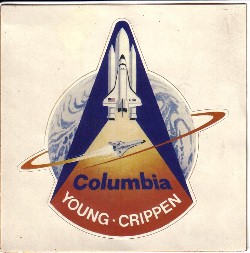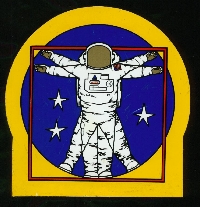Prior to the first flight, the EMU's had been through a long series of verification tests and a series of training tests had been performed with the prime and backup crewmembers. The EMU was built and tested by Hamilton Standard before it was delivered to the NASA Johnson Space Center for final testing and training. Just prior to flight, both the prime and the backup crewmembers went through daylong vacuum training runs during a one-week period.
Astronaut George 'Pinky' Nelson volunteered to be the man in the suit, or test subject, for the vacuum chamber run. He went through the usual practice runs at normal sea-level pressure (with the chamber door open) and then, on the day of the test, he spent three hours breathing 100% oxygen in the suit (prebreathing) to ensure that most of the nitrogen had come out of solution from his body fluids so that he would not get the 'bends' while the suit pressure was at the 4 psia operating pressure while at vacuum.
PHOTO CREDIT: NASA
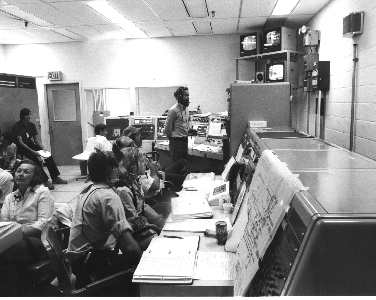
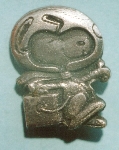 This photo shows the chamber control room in 1980 when we were doing the initial tests with the Shuttle EMU space suit. I am standing at the corner of the console. Data displays and control panels are at my right and left. The closed-circuit television monitors are in the corner of the room near the ceiling. Other test engineers and systems operators are at their stations.
This photo shows the chamber control room in 1980 when we were doing the initial tests with the Shuttle EMU space suit. I am standing at the corner of the console. Data displays and control panels are at my right and left. The closed-circuit television monitors are in the corner of the room near the ceiling. Other test engineers and systems operators are at their stations. As the test continued, chamber pressure was reduced to 5 psia for transfer from external power and oxygen to internal power and oxygen. An umbilical (SCU) from the spacecraft (from chamber facility systems in this case) to the suit supplied cooling water, sublimator water, electrical power, communications, and oxygen until it was disconnected before exiting the spacecraft. The procedure back then was to disconnect the SCU at 5 psia to avoid the possibility of freezing water in the water connectors. Now it is disconnected at vacuum. Also, we did not refer to the astronauts and test subjects by name but as Crew Member. (Crewman before women were in the program.)
PHOTO CREDIT: NASA
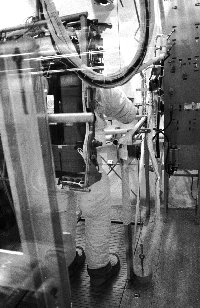 This is a view through the chamber porthole of a suit test in progress. The SCU panel is at the right and the suit support stand is at the left. The suited test subject is standing on the treadmill holding the handrails. The EMU weighs over 275 pounds and must be supported by a weight relief system to allow mobility at 1-G. The white part is the actual pressure suit and the black unit on the back is the life support system container oxygen, water, battery, carbon dioxide absorber, and all the systems required to keep a person alive while sealed inside a suit operating in a vacuum.
This is a view through the chamber porthole of a suit test in progress. The SCU panel is at the right and the suit support stand is at the left. The suited test subject is standing on the treadmill holding the handrails. The EMU weighs over 275 pounds and must be supported by a weight relief system to allow mobility at 1-G. The white part is the actual pressure suit and the black unit on the back is the life support system container oxygen, water, battery, carbon dioxide absorber, and all the systems required to keep a person alive while sealed inside a suit operating in a vacuum. The first step of the transfer was to switch electrical power from the spacecraft supply to the suit battery. Pinky got a low voltage warning when he switched. The EMU engineers looked at the dropping battery voltage and decided that it might be a characteristic of the battery to drop and then stabilize at the proper level. At that point we could have asked Pinky to switch back to the SCU supply while it was still connected, but we decided to press on. I directed the facility operator to terminate power and oxygen and then Pinky disconnected the SCU and continued preparations for depress to vacuum.
We realized that noise on the communication systems was becoming much worse than normal and then the suit fan stopped. This is a stressful thing. It could have been an electrical failure that had the potential for a fatal suit fire or, at the least, Pinky could have been overcome by heat and carbon dioxide, which were not being flushed from his helmet without the fan. (There is a purge flow option that helps, but it is not too effective except at vacuum.) The immediate decision was to reconnect the SCU and return to facility power. Although Pinky had been able to do that several times during the rehearsal run, he had this time difficulty for some reason. He final did get it connected after a struggle.
I directed the power supply operator to turn facility power back on, but in my anxiety to get Pinky back on power, I failed to request verification that we actually had power. I then directed Pinky to switch from battery to SCU and when he did, we immediately lost communications and all data. We later learned that there had been a miss-alignment in the SCU electrical connector and even though Pinky had connected it, a short had occurred. When the facility power was switched on, it dropped out immediately because of the short. This was a safety feature of course. But there we were, no comm. and Pinky had been without airflow for almost a minute.
Pinky knew to go back to battery power and when he did comm was restored much to our relief. I then directed Pinky to open the suit purge valve which helped provide a little flow to the helmet area and we began allowing air back into the chamber at the normal rate to bring the pressure back to site pressure so that chamber personnel could enter the chamber to provide assistance.
The suit helmet was removed and the waist section was opened so that Pinky could get some fresh air, but we kept him in the test location for a few minutes to do some trouble-shooting and try to recover the test. Immediately following that test we made a rule that there would be no trouble-shooting while a person was in the suit.
It was soon obvious that the battery was bad and that there was no point in continuing, so Pinky got out of the suit and the engineers began the process of correcting the problems that had occurred.
PHOTO CREDIT: NASA
 This is the primary closed-circuit television view of a subject at vacuum walking on the treadmill. The STS-1 post-flight test didn't make it this far. This test was on the 294th day of 1980. The moire pattern in the image is the result of the crossing of the scanner scan lines with the raster lines in the CRT image.
This is the primary closed-circuit television view of a subject at vacuum walking on the treadmill. The STS-1 post-flight test didn't make it this far. This test was on the 294th day of 1980. The moire pattern in the image is the result of the crossing of the scanner scan lines with the raster lines in the CRT image. Someone recently placed spacesuit tests and others training activities on YouTube. This link is to a video for Astronaut Dale Gardner's spacesuit test dry run for either Shuttle flight STS-8 in August '83 or STS-51A in November '84. I appear in the video with Gardner explaining some of the chamber features. Check this out (Astronaut Gardner spacesuit test video) and then watch this one of Astronaut Dr. Norman Thagard practicing in a spacesuit on our treadmill. (Astronaut Thagard in spacesuit on treadmill in vacuum chamber during dry run.)
EMU - The acronym for Extra-vehicular Mobility Unit, which refers to the space suit with its life support system. The letters are pronounced separately, not as a word. Extra-vehicular means outside the vehicle or spacecraft. The unit provides for mobility while outside the spacecraft.
EVA - Extra-vehicular Activity refers to the process of going outside the spacecraft (a spacesuit is required, of course) to perform activities in the vacuum of open space.
SCU - Service and Cooling Umbilical (or Supply and Cooling Umbilical?) refers to the system of hoses and electrical wiring that supplies oxygen, water, power, cooling, and communications from the spacecraft until exiting the spacecraft for an EVA.
Bends - Bends is the common word for Decompression Sickness, which can result from exposure to a lower pressure (usually a pressure less than half of what the body was previously exposed to). This sometimes happens to scuba divers who don't follow the dive tables and come up too fast. It can also happen to personnel in aircraft, spacecraft, and vacuum chamber operations if a sudden loss of pressure occurs and they had not 'prebreathed' 100% oxygen prior to exposure to the low pressure. The condition was originally called 'caisson disease' because of the great number of workers affected by it during the building of the Brooklyn Bridge. The construction caissons at the bottom of the river were pressurized to keep water out and the workers entered and exited through airlocks. They didn't know about 'dive tables' then and came immediately to the surface. They suffered excruciating pain in their joints which often seemed to be locked in a bent position - thus the 'bends.' Bubbles of nitrogen form in body tissues when the surrounding pressure is reduced just as bubbles of CO2 form in soda water when the pressure is released by popping the cap. When the bubbles form in arteries, lungs, and nerves, paralysis, blindness, or death can result. Treatment is provided by placing the victim in a pressure chamber at an appropriately high pressure combined with breathing 100% oxygen. Prevention for low pressure spacesuit operations is provided by prebreathing 100% oxygen for the time required to remove most of the nitrogen from solution in the body.
